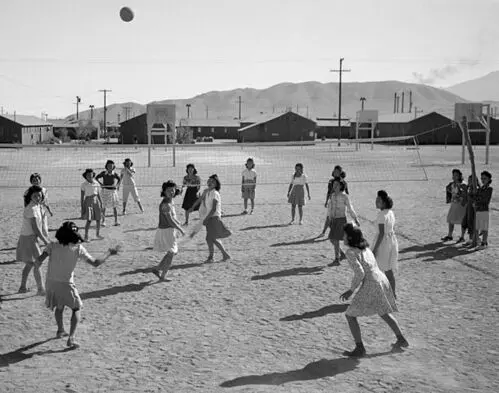Volleyball During World Wars

Volleyball During World Wars: Resilience and Adaptation
Volleyball, first invented in 1895 by William G. Morgan, rapidly gained popularity in the early 20th century as a recreational sport. However, the outbreak of World War I (1914–1918) and World War II (1939–1945) presented unprecedented challenges to societies worldwide, including the world of sports.
Despite the turmoil of these conflicts, volleyball demonstrated resilience and adaptability, continuing to thrive in unique ways during these turbulent times.
Volleyball in the Pre-War Era
Before the World Wars, volleyball had already established itself as a sport with a global appeal. Its simplicity, requiring minimal equipment, made it accessible across various cultures and environments. By the early 1910s, the game had spread beyond the United States, with YMCA missionaries introducing it to countries in Europe, Asia and South America.
As a recreational activity, volleyball was valued for its ability to foster teamwork, fitness and morale. These qualities would later prove crucial as the world plunged into war.
World War I: Volleyball in the Trenches
Impact of the War on Sports
World War I disrupted many organized sports leagues and competitions. Fields and gymnasiums were repurposed for military use and athletes joined the war effort. However, volleyball, with its adaptability, found a new role as a recreational activity for soldiers.
Volleyball Among Soldiers
Volleyball became a popular pastime for soldiers on both sides of the conflict. Its portability made it ideal for makeshift games in trenches, barracks and training camps. The game served as a brief escape from the horrors of war, offering soldiers a chance to bond and maintain physical fitness.
The YMCA played a significant role in promoting volleyball during the war. They distributed equipment and organized games for troops stationed in Europe. This effort not only helped sustain morale but also introduced volleyball to new audiences, accelerating its spread globally.
Post-War Expansion
After the war, returning soldiers brought their love of volleyball back to their communities. This post-war period saw a surge in the sport’s popularity, particularly in Europe, where it had taken root during the conflict. The international spread of volleyball set the stage for its eventual inclusion in global competitions.
The Interwar Years: Setting the Stage for Global Volleyball
Between the wars, volleyball continued to grow as a recreational and competitive sport. The first official volleyball rules were standardized during this time, providing a foundation for international play. The formation of national volleyball associations in countries like Czechoslovakia, Japan and the Soviet Union showcased its growing appeal.
However, this period of growth was interrupted by the outbreak of World War II.
World War II: Volleyball as a Tool for Resilience
Challenges for Organized Volleyball
Like World War I, the Second World War disrupted organized sports. Stadiums and gyms were again repurposed and international competitions were canceled. Many athletes enlisted and resources were diverted to the war effort.
However, volleyball adapted to these constraints. Its minimal requirements made it an ideal sport for wartime conditions, particularly for military and civilian recreation.
Volleyball in Military Training
During World War II, volleyball was actively incorporated into military training programs. Allied forces used the sport to improve soldiers’ physical fitness, coordination and teamwork. It was also a morale booster, providing soldiers with a sense of normalcy and camaraderie.
American GIs introduced volleyball to many regions during their deployment, particularly in the Pacific and Europe. Makeshift courts were set up in prisoner of war camps, military bases and liberated towns, further spreading the sport.
Volleyball in Civilian Life
For civilians, volleyball offered a form of recreation amid the challenges of wartime life. Communities organized local games to bring people together and distract from the hardships of rationing, bombings and displacement.
Schools and youth organizations, such as the Boy Scouts and Girl Scouts, also promoted volleyball as a wholesome activity for young people.
Adaptation and Innovation During Wartime
The wars prompted several adaptations to volleyball. For instance:
Simplified Gameplay: Wartime conditions often necessitated adjustments to the rules, such as smaller teams or shorter games, to accommodate limited space or time.
Improvised Equipment: Soldiers and civilians used whatever materials were available, such as makeshift nets and balls, to keep the game alive. Creativity flourished as people found ways to adapt the sport to their environment.
Globalization of the Sport: The exposure of new regions to volleyball during wartime deployments laid the groundwork for its post-war expansion. Countries that had little to no prior exposure to volleyball began to embrace the sport, contributing to its international appeal.
Post-War Resurgence and Legacy
After World War II, volleyball experienced a remarkable resurgence. The sport’s wartime role in fostering morale and teamwork translated into widespread popularity in peacetime. Several key developments shaped the post-war era:
Formation of the FIVB: The Fédération Internationale de Volleyball (FIVB) was founded in 1947, marking a significant step toward organizing volleyball at a global level. The FIVB standardized rules and established international tournaments.
Volleyball in the Olympics: The global appeal of volleyball, accelerated by its wartime spread, contributed to its inclusion in the Olympic Games. Volleyball debuted as an official Olympic sport in 1964 during the Tokyo Summer Games.
Expansion of Competitive Play: National and international volleyball competitions proliferated in the decades following the war. Countries like the Soviet Union, Japan and the United States emerged as powerhouses in the sport.
Volleyball’s Enduring Spirit
The adaptability of volleyball during the World Wars is a testament to its resilience and universal appeal. Despite the immense challenges of these periods, the sport not only survived but thrived, finding new ways to connect people across borders and circumstances.
Today, volleyball continues to embody the values it demonstrated during the wars: teamwork, perseverance and the power to bring people together. Its wartime history is a poignant reminder of how sports can serve as a source of hope and humanity, even in the darkest times.


